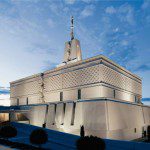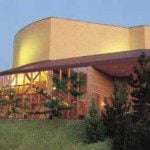
(Wikimedia Commons public domain photograph)
I’m afraid that, owing to the demands of our travel schedule and other factors, I’ve been recounting our adventures somewhat out of order. I apologize for that. But it can’t really be helped. In fact, I’ll backtrack a little bit in this entry, yet again.
On Friday, 1 November, we were up characteristically early. We had breakfast right on the shore of the remarkably pretty Lake Catemaco and, across the water in the distance, were able to see Cintepec, the small peak that might be the Book of Mormon’s Hill Shim. (The previous night, we had arrived after dark and, so, were unable to see it.)
Then we drove to a vantage point from which we could look out over the town of Santiago Tuxtla and, behind it, Cerro Vigia, which is probably the leading candidate to be the location of the final battle of the Nephites and, before them, of the Jaredites:
2 And I, Mormon, wrote an epistle unto the king of the Lamanites, and desired of him that he would grant unto us that we might gather together our people unto the land of Cumorah, by a hill which was called Cumorah, and there we could give them battle.
3 And it came to pass that the king of the Lamanites did grant unto me the thing which I desired.
4 And it came to pass that we did march forth to the land of Cumorah, and we did pitch our tents around about the hill Cumorah; and it was in a land of many waters, rivers, and fountains; and here we had hope to gain advantage over the Lamanites.
5 And when three hundred and eighty and four years had passed away, we had gathered in all the remainder of our people unto the land of Cumorah.
6 And it came to pass that when we had gathered in all our people in one to the land of Cumorah, behold I, Mormon, began to be old; and knowing it to be the last struggle of my people, and having been commanded of the Lord that I should not suffer the records which had been handed down by our fathers, which were sacred, to fall into the hands of the Lamanites, (for the Lamanites would destroy them) therefore I made this record out of the plates of Nephi, and hid up in the hill Cumorah all the records which had been entrusted to me by the hand of the Lord, save it were these few plates which I gave unto my son Moroni. (Mormon 6:2-6)
Please note, by the way, the important fact that Mormon buried in the hill that he mentions all of the records in his possession except for those that I handed over to his son Moroni. Those are the plates, presumably, that Moroni ultimately buried in the hill in western New York nearly three and a half decades after the cataclysmic final Nephite battle and that, in the early nineteenth century, he delivered to the Prophet Joseph Smith.
And here is a reference to Cumorah (aka Ramah) in Moroni’s account of the final Jaredite battle:
11 And it came to pass that the army of Coriantumr did pitch their tents by the hill Ramah; and it was that same hill where my father Mormon did hide up the records unto the Lord, which were sacred.
12 And it came to pass that they did gather together all the people upon all the face of the land, who had not been slain, save it was Ether. (Ether 15:11-12)
After looking out over the likely site of the destruction of both the Nephites and the Jaredites — fittingly enough, on the day celebrated in México as the “Day of the Dead” (the Día de (los) Muertos) — we continued through a large area of ponds and marshes that can, I think, be plausibly identified with “the waters of Ripliancum” as mentioned in the Book of Mormon. I’m told, too, that the area through which we passed was described among the Aztecs by a term, in Nahuatl, that bears the meaning of something like “exceeding large waters”:
7 And when Coriantumr saw that he was about to fall he fled again before the people of Shiz.
8 And it came to pass that he came to the waters of Ripliancum, which, by interpretation, is large, or to exceed all; wherefore, when they came to these waters they pitched their tents; and Shiz also pitched his tents near unto them; and therefore on the morrow they did come to battle. (Ether 15:8)
When we reached Veracruz, we enjoyed a good early dinner in a Mexican chain restaurant called Vips, walked around the beautiful little Veracruz México Temple nearby, and caught an evening flight to Mexico City, the last destination of our tour. It’s been interesting to see the temporary Day of the Dead Shrines, and the costumes, and the holiday face painting. The holiday is a combination of Halloweenish fun and somewhat solemn memorials to the departed dead. I would imagine that the particular mix varies from person to person, from family to family, and from place to place.

Posted from the Ciudad de México, México













